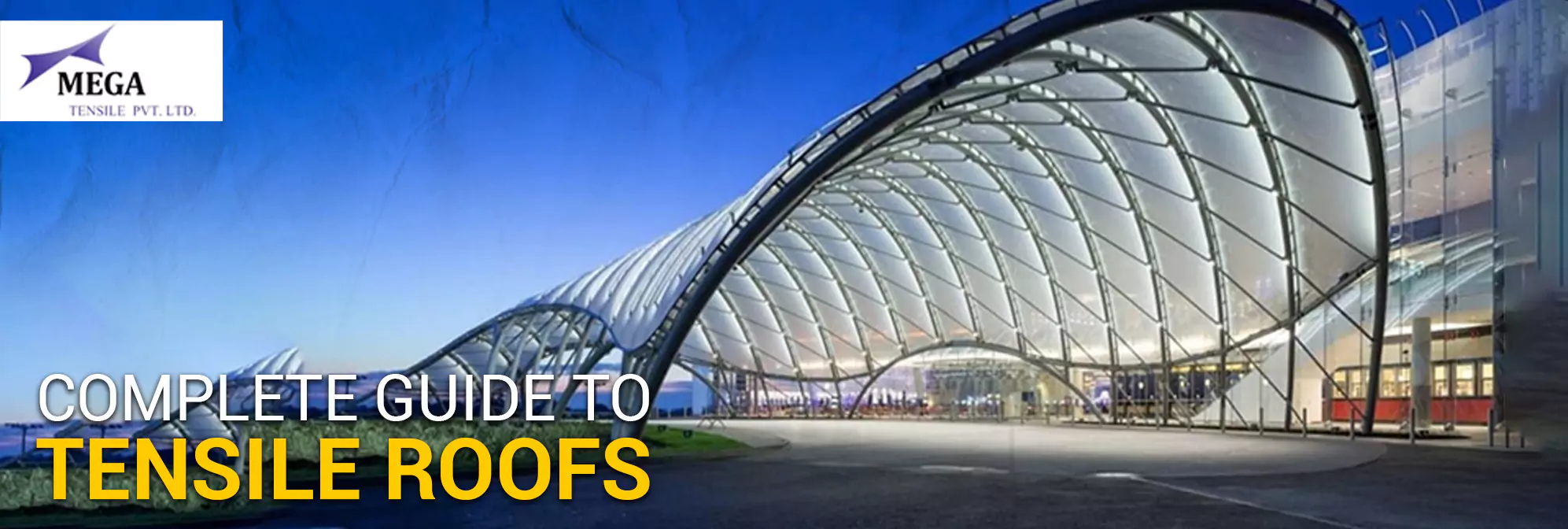Where Are Tensile Roof Structures Commonly Used? A Complete Guide
Admin / Feb 14, 2025

The modern tensile roof structure has gained popularity in architecture because of its dramatic contours great durability, and construction. Along with more complex aesthetics, modern architectural structures have practical benefits, which allow them to be used for a wide range of purposes. Today, tensile roofs are more widely used in places where large areas need to be covered – whether for commercial, residential or public structures. This guide will provide insights into the common applications of tensile roof structures and how suitable they are for the given spaces.
What Are Tensile Roof Structures?
Tensile roofs are a form of construction that can be considered roofing systems that are made from fabric and are of low weight. They use roofing membranes and fabric to create a structural framework that has some form of high strength. The standard materials used in this construction include PVC, PTFE and ETFE. These materials allow for some form of flexibility due to being resistant to a variety of weather conditions, which in turn ensures minimum maintenance is required.
Because of their versatility and their potential for inventiveness in design, tensile roof structures can be adapted to fit various kinds and functions of buildings which allows for various uses of such structures.
Key Benefits of Tensile Roof Structures
Before exploring their common uses, it is important to understand why tensile roof structures are favoured in modern construction:
Flexibility in Design: Since tensile roofs can be created into any imaginative geometric form, they can effortlessly adorn spaces for architectural beautification.
Cost-Effectiveness: They do reduce cost by requiring fewer materials and having a more easy installation compared to conventional roofs.
Durability and Weather Resistance: Because of the strong fabrics made weather-resistant by means of coated materials, they are able to resist severe environments.
Natural Light Utilization: Various tensile fabrics are light transparent, so the need for artificial light in the daytime is reduced.
Eco-Friendliness: The use of lightweight materials and the requirement of smaller structural components limit the effect of construction on the environment.
Read Also:- What Are the Maintenance Requirements for Tensile Roof Structures?
Top Locations Where Tensile Roof Structures Are Commonly Used
Facilities and Stadiums
Tensile roof structures are especially popular in sports arenas and stadiums, as they can cover big spaces with very few supporting structures. These roofs protect players and spectators from the weather while still letting sunlight into the building. Stioda, there are at least a couple of well-known stadiums, for example, where large tensile roofs are used to offer a better cover and provide a wider range of functional and design bases.
Commercial Spaces (Malls and Retail Centers)
The use of tensile roof structures is quite common in commercial spaces such as malls and retail centres for their atriums, entrances and other spaces. Such structures enhance the modern feel of the place and create an atmosphere that is aesthetically pleasing by letting in natural sunshine. They further provide branding options with unique designs and colours.
Transportation Hubs (Airports and Railway Stations)
Aesthetic design and functional features form the two basic requirements for roofing solutions in airports and even railways. Football Tensile structures are perfect for these areas due to their ability to cover large spans while obstructing visibility which makes it ideal for use in terminals, waiting areas and drop-off areas.
Event Spaces and Exhibition Centers
For both, permanent and temporary event locations, tensile roofs are considered to be one of the best options. Aesthetics, ability to cover vast space, and quick installation make them ideal for concert stages, exhibition centres and outdoor fairs. The ease of disassembling them also makes tensile roofs perfect for temporary events.
Educational Institutions (Schools and Universities)
Educational institutions often use tensile roof structures for playground covers, outdoor seating areas, and assembly halls. These structures provide shade and protection from the elements, making outdoor spaces more functional for students and staff.
Public Spaces and Parks
Public spaces such as parks and community centres frequently incorporate tensile roof structures for seating areas, amphitheatres, and walkways. These structures enhance the visual appeal of public areas while offering protection from sun and rain, making spaces more inviting and functional.
Residential Spaces
In residential settings, tensile roof structures are commonly used for patios, garden covers, and car parking shades. Their ability to blend style with functionality makes them a popular choice among homeowners looking to enhance their outdoor spaces with minimal structural impact.
Why Are Tensile Roof Structures Ideal for These Spaces?
The application of Tensile membrane structures has an ideal functionality due to how visually appealing and cost-effective this architecture can be. The ability to provide large areas with minimal structural support expands the offerings of architects and designers. Additionally, an adequate resistance to weather elements and an extended lifespan make this type of roof ideal both for permanent and temporary constructions.
For those looking to incorporate innovative roofing solutions, opting for a Tensile Roof Structure in Faridabad can be a perfect choice, as it offers both modern design and practical benefits suitable for various projects.
Conclusion
The lightweight, visually appealing, and functional characteristics of tensile roofs have dramatically changed contemporary architecture. These roofs are being used in sports stadiums, business centres, residential verandas, and even in public areas like parks, with the perfect combination of style and performance. They are popular in many fields because they are inexpensive and can cover a wide area.
If you're planning a project that requires innovative roofing solutions, considering tensile roof structures can be an excellent decision for both style and practicality.



